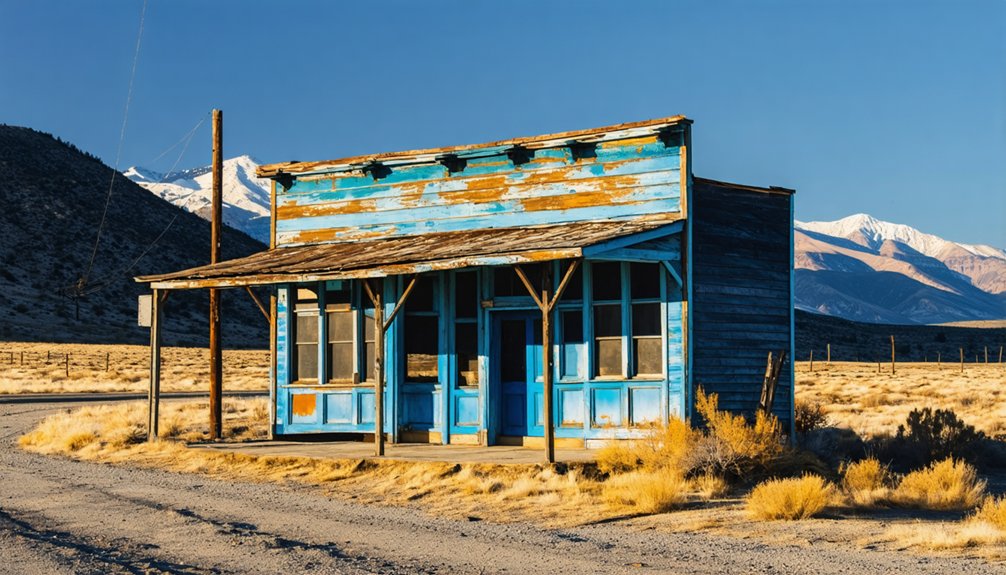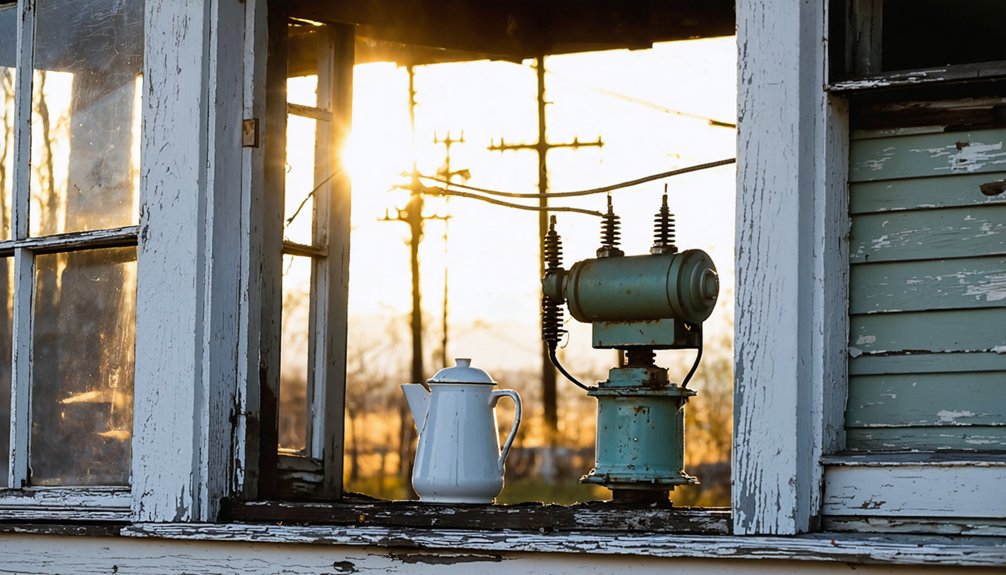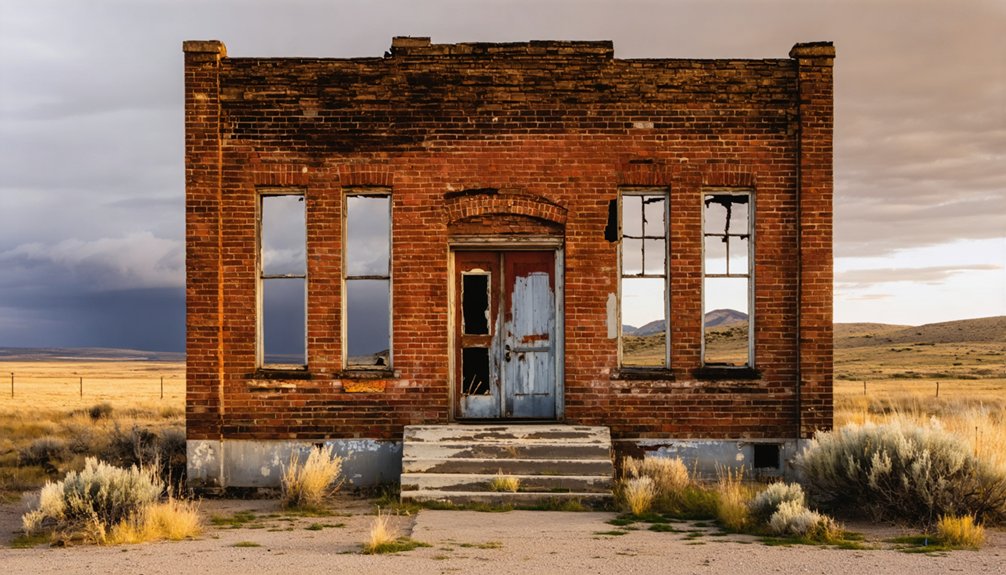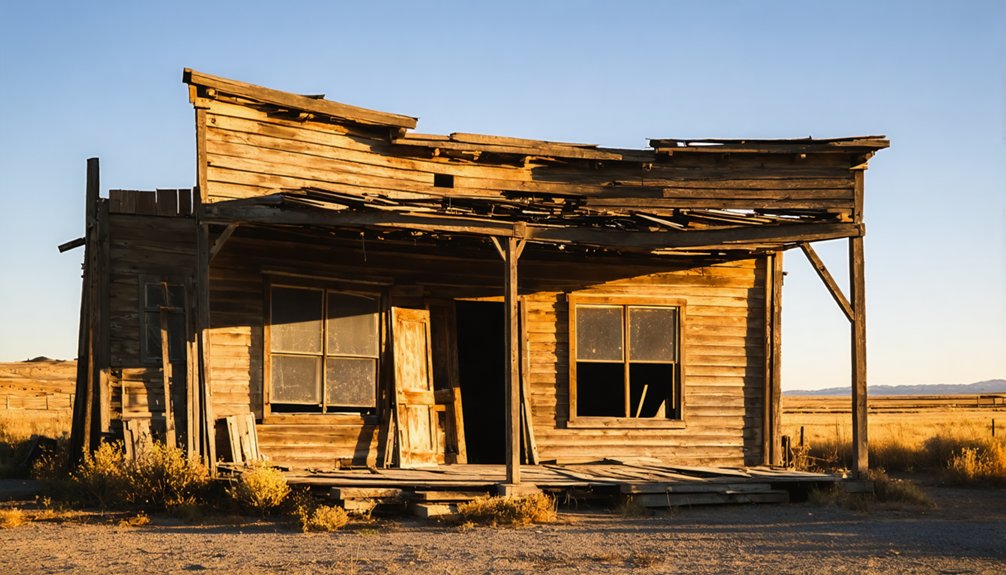You’ll find Paradise Ghost Town hidden in Idaho’s rugged Sawtooth National Forest, where gold fever once drew prospectors in the late 1800s. This remote settlement thrived briefly with homes, hotels, and saloons, powered by electricity from 1916 onwards. Today, you’ll need an off-road vehicle or hiking boots to reach the weathered remains, as unpaved forest service roads lead to this historic mining site. The crumbling structures and mining remnants hold fascinating tales of frontier determination.
Key Takeaways
- Paradise Ghost Town is a remote abandoned mining settlement in Camas County, Idaho, accessible only through rugged terrain in Sawtooth National Forest.
- The town flourished during the late 19th century gold rush but declined due to mining operation challenges and financial schemes.
- Visitors can explore deteriorating architectural remains including home foundations, a hotel, and saloons, though some areas are private property.
- Best access is during late spring through early fall, requiring off-road vehicles or hiking boots, with no standard vehicle access.
- The site requires thorough preparation, including GPS, maps, and supplies, as there are limited services and sparse signage.
The Journey to Paradise: Location and Accessibility
While many Idaho ghost towns beckon visitors with well-marked highways and maintained roads, Paradise Ghost Town challenges adventurers with its remote northern Idaho location in Camas County.
Unlike its more accessible counterparts, Paradise Ghost Town demands true adventurers willing to venture far from civilization’s comforts.
You’ll need to navigate through the rugged terrain of Sawtooth National Forest, where unpaved forest service roads and seasonal trails serve as your only passage to this hidden treasure.
The journey’s navigation challenges are balanced by the natural beauty surrounding you – dense forests, mountain peaks reaching nearly 10,000 feet, and the pristine waters of Paradise and Emma creeks.
Paradise Peak rises to an elevation of 9,798 feet above sea level, dominating the landscape and serving as a natural landmark for visitors.
Similar to many locations listed in disambiguation pages, Paradise Ghost Town shares its name with several other historic sites across America.
You’ll want to pack your GPS and topographic maps, as signage is sparse. Plan your visit during favorable weather, as snow and rain can make the already difficult terrain treacherous.
Don’t forget your off-road vehicle or hiking boots – standard cars won’t make this trip.
Mining Dreams and Financial Schemes
The promise of gold drove Paradise’s founding in the late 19th century, as prospectors followed the guidance of local Nez Perce members like Wild Dove to promising creek beds and hillside claims.
You’d find mining innovations scattered across the rugged landscape, where enthusiastic entrepreneurs poured their fortunes into extracting precious metals from the Idaho hills.
But for many investors, Paradise proved to be anything but heavenly. Financial schemes and investment pitfalls plagued the town’s development, as mining companies oversold their prospects to wealthy backers.
While some operations showed initial promise, the harsh reality of high operational costs, difficult terrain, and inconsistent yields soon set in. Supplies had to be hauled in from Walla Walla traders, making operations even more expensive.
What started as a bustling hub of activity gradually succumbed to the boom-and-bust cycle that claimed so many Western mining towns, much like Silver City which became the world’s largest silver mining area before its eventual decline.
Life in a Remote Mountain Settlement
Living in Paradise meant confronting nature’s extremes head-on, as settlers like Anbury Lieuallen carved out homesteads from the rugged mountain terrain in the 1870s.
You’d face bitter winters and harsh conditions while building a life in this remote valley, where pioneer challenges tested even the strongest spirits.
Yet you weren’t alone in this struggle. The community’s resilience showed in how neighbors helped each other dig irrigation ditches, share resources, and organize social gatherings that kept spirits high.
In Paradise Valley, hardship bred unity as neighbors joined forces to build, share, and celebrate their growing community together.
The first post office in 1872 brought vital connections to the outside world, marking Paradise Valley’s growing significance.
Danish and Swedish immigrants added their cultural traditions to the mix, enriching community life. Like early settlers across Owyhee County, residents had to master experimental farming techniques to transform the sagebrush terrain into productive land.
You’d find yourself adapting quickly, learning to raise cattle and grow hay in the mountain climate, trading with passing miners, and relying on innovation to overcome the isolation.
Despite limited access to services, you’d discover that Paradise’s greatest strength lay in its people’s determination to succeed together.
The Rise and Fall of Paradise
As precious metals beckoned fortune-seekers to Idaho’s mountains in the late 19th century, Paradise emerged as a promising mining settlement where you’d find prospectors and entrepreneurs building a frontier community from scratch.
Despite harsh conditions, you’d witness remarkable community resilience as the town grew to include boarding houses, shops, and essential services supporting the mining operations. Like many mining settlements, the residents endured harsh weather conditions while pursuing their dreams of striking it rich. Similar to nearby Yankee Fork Gold Dredge, the town’s mining operations were crucial to its survival.
The economic fluctuations typical of mining towns ultimately sealed Paradise’s fate. Once-profitable ore veins depleted, and the mines that had sustained the town’s prosperity began to close.
You’d have seen workers and their families departing for more promising opportunities elsewhere, leaving behind empty buildings and silent mine shafts.
Today, Paradise stands as a reflection of the boom-and-bust cycle that defined so many Western mining communities.
Architectural Legacy and Remaining Structures
Walking through Paradise today, you’ll find a haunting collection of architectural remnants that tell the story of this once-bustling mining settlement.
Silent stone walls and crumbling foundations echo the memories of Paradise, where a once-thriving mining community carved out its existence.
As you explore the site, you’ll discover the foundations of what used to be homes, a hotel, and several saloons, though most have succumbed to structural deterioration over time. Some areas are marked with private property signs, limiting full access to certain historical structures. The town’s architectural preservation has been challenged by harsh weather conditions, leaving only a few standing structures as evidence to its mining-era heritage. Similar to Wallace, where every downtown building is on the National Register of Historic Places, Paradise showcases the architectural importance of Idaho’s mining era.
What makes Paradise particularly fascinating is its advanced infrastructure for its time, including electric power – a rare feature for a remote mining town.
You can access these historical remains by taking a five-mile trek along an old wagon road, where you’ll witness firsthand how nature has slowly reclaimed this piece of Idaho’s mining history.
Weather’s Impact on the Ghost Town
While Paradise’s architectural remnants stand as proof to Idaho’s mining history, the town’s harsh climate continues to exact a heavy toll on its surviving structures.
You’ll find the weather effects particularly severe during winter months, when temperatures can plunge to an astounding -50°F. These extreme cold temperatures, combined with seasonal challenges like freeze-thaw cycles, accelerate structural decay throughout the ghost town’s remaining buildings.
Snow accumulation poses another significant threat, as heavy loads stress aging roofs and foundations. When this snow melts, the resulting runoff undermines structural stability.
You’ll notice the persistent wind abrasion has worn down exposed surfaces over time, while wind-driven moisture penetrates wood and masonry. These combined forces transform the town’s historic structures into increasingly fragile reminders of the past.
Paradise vs. Other Idaho Mining Towns

Unlike many of Idaho’s gold rush boomtowns, Paradise carved out a distinct identity through its specialized role in silver and lead processing. While towns like Mackay and Custer focused on single-commodity extraction, you’ll find Paradise’s legacy deeply rooted in its extensive smelting operations and industrial heritage.
The mining comparisons between Paradise and other ghost towns reveal stark contrasts. Where Gold Creek and similar camps left minimal traces, Paradise’s industrial ruins and ecological impact tell a more complex story.
You’re looking at a town that didn’t just fade away when ore ran out – it left behind a challenging environmental legacy. The Bunker Hill smelter’s pollution created a Superfund site that sets Paradise apart from other mining communities, where abandoned shafts and scenic ruins now draw adventure tourists.
Daily Life and Community Features
Through the bustling streets of Paradise’s heyday, you’d find a vibrant yet stratified community where mine workers, merchants, and wealthy operators carved out distinct social spheres.
Paradise’s streets revealed a world divided by class, where miners, merchants, and mine owners lived in separate social realms.
The social hierarchy was clear, with miners enduring harsh conditions while merchants and mine owners enjoyed greater privileges and influence over local governance.
Daily life centered around these key community features:
- The general store and saloon served as gathering spots where you’d catch the latest mining news and participate in community gatherings.
- Basic wooden structures housed residents, from simple miners’ cabins to more substantial merchant quarters.
- Rough-hewn roads connected Paradise to essential trade routes, though you’d face challenging travel conditions.
Despite limited amenities and poor sanitation, the tight-knit community fostered a resilient spirit through shared cultural events and mutual support.
The Era of Electric Power in Paradise

You’ll find Paradise’s first encounter with electric power came in 1916 when Idaho Power began extending its infrastructure into the remote mining settlement as part of its rural electrification efforts.
The arrival of reliable electricity transformed the mining operations in Paradise, allowing for more efficient ore processing and improved working conditions in the mines.
Idaho Power’s early investment in Paradise’s infrastructure would continue to serve the community until its eventual decline, leaving behind power line remnants as silent witnesses to the town’s electrified past.
Early Power Infrastructure Development
When Idaho Power formed in 1916, it marked a transformative moment for Paradise’s electrical infrastructure, consolidating five regional power companies and nine hydroelectric plants into a unified system with 20 MW of generating capacity.
You’d find early power development concentrated along the Snake River, where the dramatic 2,500-foot elevation drop created ideal conditions for hydroelectric generation.
The remote access challenges of Paradise were addressed through:
- A robust transmission network of 933 miles connecting 57 substations
- Strategic placement of hydroelectric facilities on the Snake River and its tributaries
- An infrastructure serving 150,000 people across the region’s rugged terrain
The utility’s growth mirrored Idaho’s expanding population, with Paradise benefiting from the reliable power that drove economic development throughout the Magic Valley region.
Electrification’s Impact on Mining
The arrival of electric power revolutionized Paradise’s mining operations in the early 1900s, transforming what had been a manually intensive industry into a model of industrial efficiency.
You’d find electric-powered crushing mills and grinding equipment replacing older steam-driven machinery, dramatically increasing the mine’s ore processing capacity.
The electrification benefits extended underground, where electric hoists, pumps, and ventilation systems allowed miners to dig deeper and work safer.
Electric lighting illuminated the darkness below, while automated sorting machines recovered more precious metals from complex ores.
You can still trace the remnants of electric rail lines that once transported ore through the tunnels.
This mining technology boom helped Paradise’s mines remain viable even as ore grades declined, though ultimately it couldn’t prevent the town’s eventual abandonment.
Lasting Legacy of Power
Power’s transformative reach extended far beyond Paradise’s mines, shaping the town’s broader development through Idaho’s pioneering hydroelectric projects of the early 1900s.
You’ll find Paradise’s story intertwined with the region’s hydro power evolution, from early local generators to Idaho Power’s expansive grid system.
- The Snake River’s mighty dams – Swan Falls, Shoshone Falls, and later the Hells Canyon Complex – delivered reliable electricity that transformed Paradise from a mining outpost to a more diversified community.
- Idaho Power’s consolidation of regional utilities in 1915-1916 brought stability and growth to Paradise through an interconnected power network.
- When energy conservation became critical in the 1970s, Paradise adapted alongside Idaho Power’s shift from consumption-based marketing to efficiency-focused solutions.
Paradise’s electric legacy reflects Idaho’s broader journey from isolated power plants to a robust, environmentally conscious energy system.
Exploring Paradise Today: A Visitor’s Perspective
Modern-day visitors to Paradise, Idaho will discover a hauntingly beautiful ghost town nestled in Bear Lake County’s rugged terrain.
You’ll find weathered cabins and mining structures standing in arrested decay at 6,000 feet elevation, offering authentic glimpses into frontier life. The quiet solitude you’ll experience here enhances the historical significance of this former mining community.
To explore Paradise, you’ll need to plan ahead. The town’s accessible via rural roads during late spring through early fall, but you’ll want an off-road capable vehicle for some routes.
There aren’t any services in town, so pack supplies and offline maps since cell coverage is limited. While exploring the old charcoal kilns and hiking paths, you’ll find informational signs that help piece together Paradise’s compelling mining heritage.
Frequently Asked Questions
Are There Any Known Deaths or Accidents Recorded in Paradise’s Mining Operations?
Where there’s smoke, there’s fire – you’ll find mining safety records reveal historical accidents and deaths in Paradise’s operations, though specific numbers aren’t well documented compared to nearby disasters like Sunshine Mine.
When Was the Last Permanent Resident Known to Have Lived in Paradise?
You won’t find records naming the last resident of this remote site, though local ghost stories suggest the final inhabitants likely left by the 1930s, following patterns of nearby mining towns.
What Native American Tribes Originally Inhabited the Paradise Area Before Mining?
For thousands of years, you’d have found Shoshone culture flourishing here, with Bannock and Northern Paiute peoples sharing these ancestral lands, utilizing hot springs and Snake River valleys for winter settlements and sacred traditions.
Were There Any Significant Mineral Discoveries That Went Unreported or Unexploited?
You won’t find evidence of unreported minerals or unexplored deposits in this area. Records show no significant undocumented discoveries, though minor placer gold finds could’ve occurred like elsewhere in Idaho.
Did Paradise Have a Schoolhouse or Formal Education System for Children?
Like a beacon of learning, you’d have found Paradise’s five-classroom schoolhouse operating from 1910-2013, teaching generations of local children until enrollment dwindled to just five students, before becoming today’s Paradise Center.
References
- https://idahouncovered.com/idaho-ghost-towns/
- https://oregontrailgenealogy.com/the-ghost-town-thats-really-a-ghost/
- https://wheninyourstate.com/idaho/this-peaceful-idaho-ghost-town-was-once-americas-most-dangerous-mining-camp/
- https://liteonline.com/eerie-video-shows-whats-left-of-one-of-idahos-most-unique-ghost-towns/
- https://www.hcn.org/issues/issue-94/pollution-in-paradise/
- https://www.ghosttowns.com/states/id/ironsprings.html
- https://www.onlyinyourstate.com/trip-ideas/idaho/id-fishing-town
- https://en.wikipedia.org/wiki/Paradise_Peak_(Idaho)
- https://en.wikipedia.org/wiki/Paradise_Valley
- https://kellycodetectors.com/content/pdf/site_locator_books/ID.pdf



